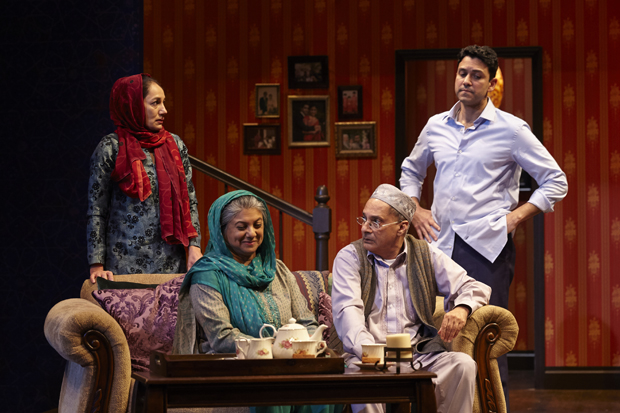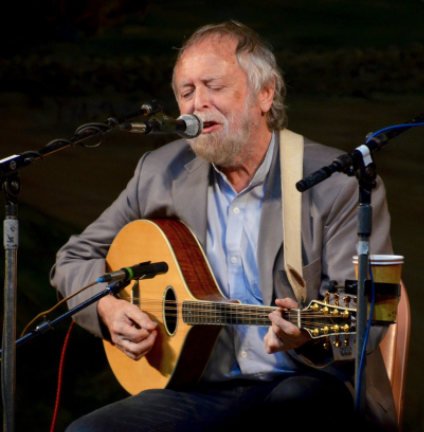by Samuel L. Leiter
A reverential hush blanketed Rose Hall at Lincoln Center as over 1,000 spectators waited patiently for the opening program of the Kanze Noh Theatre to begin. The subdued atmosphere was not unlike what one would experience at noh in Japan, unlike the more animated behavior found at kabuki. Noh has been refined to a remarkable degree over the centuries, especially after it became the official ceremonial court music of the military dictatorship that ruled Japan from 1603-1868.
Noh embodies an aesthetic of austerity, elegance, and interiority. A flautist and two or three drummers sit upstage, and a chorus of six to eight sits at stage left. Depending on the play, the actors can range from motionless to highly active; to eyes unfamiliar with noh, its plays will seem rather static, both physically and dramatically. Noh acting is referred to in Japanese as dancing, even when there’s barely any movement, and regardless of the speech or chanting required.
The stage is an exquisite wooden structure consisting of a square, thrust platform with a pillar at each corner supporting an ornate roof, an upstage wall with a pine tree painted on it, and an angled bridgeway, upstage right, for entrances and exits. Most touring productions only hint at these features; unusually, this production is graced with a relatively complete replica of a noh stage, albeit with short, truncated pillars and no roof to support. Noh theatres seat the audience on two sides of the thrust; at the Rose the stage is simply placed on a proscenium stage. An overhead screen allows for surtitles.
The actors belong to the Kanze School, the most prestigious of noh’s five schools; its name derives from those of two 14th-century actors deemed the art’s founders, Kan’ami and his son Zeami. Later this year, the Kita School will perform at the Japan Society. Six different programs mixing and matching seven pieces are being presented; half offer three plays, the other half two.
The opening program included Okina and Hagoromo (The Robe of Feathers). Okina, revered for its auspicious, even sacred qualities, is a solemnly joyous Shinto ritual performance produced for felicitous occasions. The oldest piece in the repertory, it dates back to before noh itself was born, uses an incantatory language (don’t look for surtitles), and, expresses a wish for peace and longevity through the dancing of three figures, the masked Okina (Kiyokazu Kanze), a role only the head of a school may play; his unmasked companion, Senzai (Saburota Kanze); and the masked Sanbasō (Yasutarō Yamamoto), a role danced by an actor from the kyōgen genre, associated with noh. Earlier this year, the kabuki version of this piece, Sanbasō, was staged at Carnegie Hall as part of a program starring kabuki actor Ichikawa Ebizō.
Two other programs also include just Okina and a single play. I suspect Okina will be of interest mainly to those with strong interests in theatre history and anthropology. For anyone going to only one program, I suggest they’ll find those offering three standard plays (two noh and one kyōgen) more appealing.
Hagoromo is a delicate play by Zeami about an angel (Yoshinobu Kanze) who comes to earth to bathe in the sea, leaving her gorgeous robe hanging on a pine. A fisherman (Tsuneyoshi Mori) finds the robe and, hoping to keep it as a “national treasure,” refuses to return it. Moved by the angel’s tears, he relents but only if she dances for him. She dons the robe and her exquisitely slow, ethereal, controlled dance satisfies the fisherman; she then glides off down the bridgeway as she ascends to heaven.
There was an interesting reaction when the audience laughed at the fisherman’s fear that the angel might renege on her promise. It’s extremely rare that a noh play ever stirs laughter in Japan; hearing the New York crowd (which, of course, included many Japanese residents) chuckle suggested not only how deeply invested it was in the tale but that it couldn’t resist sharing the fisherman’s cynicism. Could it be something that they noh?
Kanze Noh Theatre
Lincoln Center’s Frederick P. Rose Hall (Lincoln Center Festival)
3 Columbus Circle, NYC
July 13-17






















